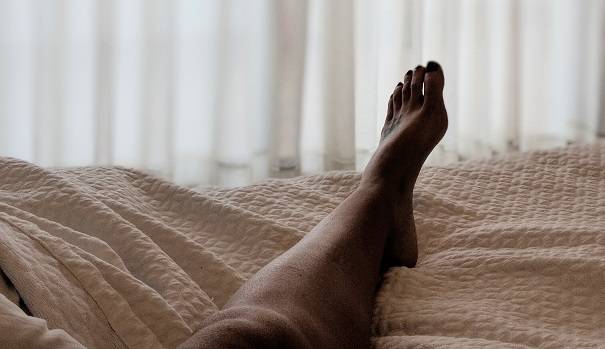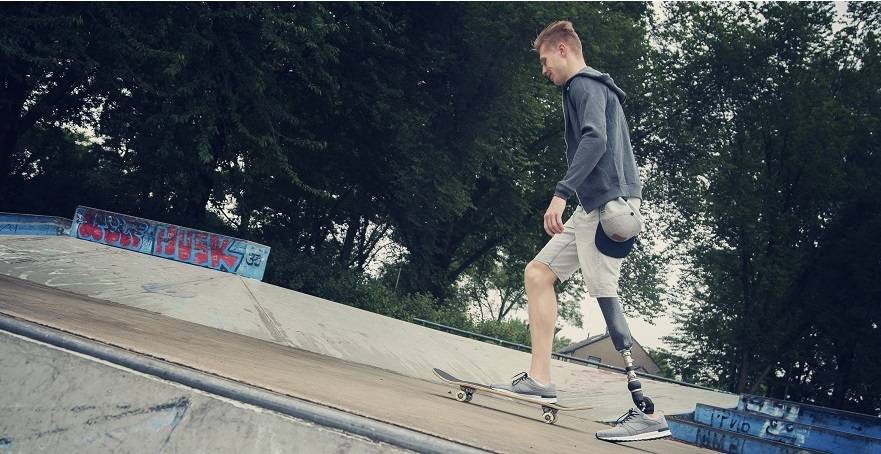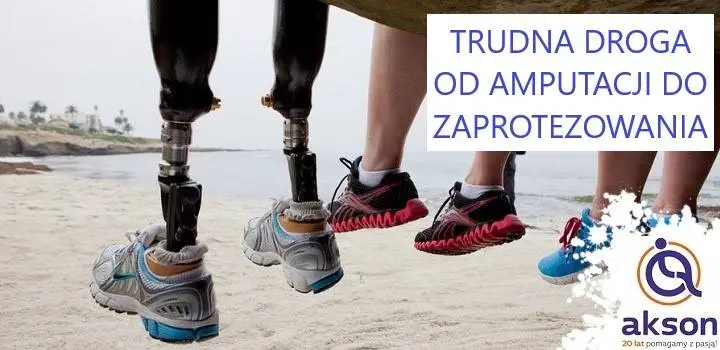Your cart is currently empty!
The infamous title of leader
Every year in Poland, about 30,000 people undergo amputations due to injury, accident, cancer or other, usually chronic, conditions. The numbers are increasing every year, despite the fact that amputation is the most radical treatment and is theoretically used when there is no longer an alternative and the patient’s life is at risk. In practice, treating complications, such as those caused by improperly treated diabetes, is much more expensive than cutting off a limb. Chronic treatment is not adequately funded, the diabetic foot patient brings losses to the hospital. For this reason, as well as through lack of easy access to professional treatment of complications, we are the European leader in terms of the number of amputations.
Amputation surgery
The problem for those who have experienced the need for amputation begins at the stage of waiting for surgery. Medical personnel lack the ability to convey the information that the limb can no longer be saved. There is a lack of psychological care for patients and generally interdisciplinary cooperation between surgeons, orthopedists, physiotherapists and psychologists. In order to perform the procedure, it is necessary to obtain the patient’s informed consent. Only in the case of unconscious patients in a life-threatening condition – the decision is made by a doctor.
Everything is changing
It is impossible to estimate how long it takes to mentally and physically accept the absence of a limb and learn to function without it. At every stage of recovery, support is needed from loved ones and professionals focused on helping amputees. It will also help to talk to a person who has gone through this difficult stage and has returned to everyday life with already recovered energy.
Psychological care
The decision was made – the limb was removed and the patient’s life saved. Is it still the same life? Everyone experiences it differently, but according to a pattern that reflects the difficulties of some patients, first there is a phase of shock and denial – the patient does not accept the loss of a limb. Anger and bitterness emerge. The next stages are related to the surge of thoughts and feelings that were previously not allowed to come to oneself and their gradual taming. When the patient succeeds in confronting difficult thoughts and feelings with reality, the trauma experienced becomes part of himself – he comes back to life, begins a new phase of his story.

Not every amputee patient requires psychological care. Help is recommended especially when the cause of the amputation becomes a psychological burden, associated with feelings of guilt and harm. Such emotions can be managed with therapy.
Rehabilitation
After discharge from the hospital, physiotherapy is needed as soon as possible. Of course, in the early postoperative phase, the most important thing is to heal the wound and strengthen the remaining limbs. The beginning of rehabilitation serves to strengthen muscles and prevent contractures. It is important to implement exercises from the first day after amputation with the goal of gradually getting the patient up and running. The mainstay is exercise to prevent complications related to the patient’s reduced activity, to support lung ventilation – breathing exercises. After that, isometric exercises, anticoagulation exercises can be introduced, and then already attempts at uprighting and movement, up to climbing stairs without assistance. Of course, the pace and intensity of exercise is an individual matter, the most important thing is regular physical activity, preferably under the guidance of a physiotherapist.
Phantom pains
An issue directly related to amputation is phantom pains. They are strongly felt in the amputated, non-existent part of the limb. Such pain can reach varying degrees of intensity, for some it will be just an episode, for others it will be months or even years of suffering. The measures used to support the patient during this difficult period depend on individual needs. It is possible to alleviate the discomfort through various pharmacological agents: anti-inflammatory, anticonvulsants or antidepressants. You can also be assisted by non-invasive massage techniques, electrostimulation or compresses. Sometimes the only option is surgical removal of the neuroblastoma.
Limb in new shape

Zaraz po amputacji pojawia się obrzęk, gdy zniknie, można zacząć formowanie kikuta, bo to od jego stanu zależeć będzie skuteczne korzystanie z protezy. Na każdym etapie rehabilitacji higiena kikuta stanowi kluczowe zagadnienie. Jego mycie należy zacząć zaraz po ściągnięciu szwów i zagojeniu się rany. Zawsze musi zostać delikatnie wytarty do sucha i codziennie obserwowany na wypadek ewentualnych komplikacji. Każde zaczerwienienie czy obrzęk są sygnałem do natychmiastowej interwencji.
Formowanie kikuta najlepiej zacząć od bandażowania, ważne jest aby kompresować go regularnie, aż do pobrania miary na protezę. Najczęściej używa się bandaża elastycznego, ale fizjoterapeuta może wybrać odpowiednie pończoszki kikutowe. Z powodzeniem stosuje się też w tym celu silkonowe lejki. Wszystkie te metody są przeznaczone na okres dziennych aktywności, noc to czas na regenerację i odpoczynek.
The stump still needs to be hardened, accustomed to the pressure of the prosthesis, before it is prosthesized. From a massage involving stroking, kneading and patting, you eventually have to come into contact with a hard surface – placing the stump on a bench, standing on the healthy limb, while practicing balance.
Adaptation of the prosthesis
Po wygojeniu rany pooperacyjnej i odpowiednim przygotowaniu, poprzez formowanie i hartowanie, kikuta, możemy przystąpić do pobrania miary na protezę. Decyzja o założeniu protezy powinna zapaść jak najszybciej po amputacji. Żeby chodzić, potrzebne są wyćwiczone mięśnie i sprawnie pracujące ośrodki mózgu, stymulujące ich pracę. Po kilku latach spędzonych na wózku wszystkie te funkcje zostaną zaburzone. Do tego mogą pojawić się przykurcze, które uniemożliwią poruszanie się w protezie. Proces pielęgnacji i rehabilitacji pacjenta po amputacji kończyn dolnych jest długofalowy i obejmuje przygotowanie kikuta do zaprotezowania, wzmocnienie całego organizmu oraz naukę chodzenia – wykorzystując kule łokciowe lub balkonik, a zastosowanie protezy jest dopiero uwieńczeniem tych starań. Na początek wykonywana jest proteza tymczasowa, potrzebna na czas formowania kikuta. Jest to również czas dla pacjenta, który musi nauczyć się dbać o kikuta, protezę i przede wszystkim uczynić z chodzenia z nią swoją codzienność.
Dopasowaniem protez zajmuje się zakład ortopedyczny na podstawie skierowania. Co trzy lata jest możliwość skorzystania z częściowego dofinansowania do protezy. System nie jest jednak zindywidualizowany – nie uwzględnia wieku, potrzeb i aktywności pacjenta. Dodatkowej pomocy finansowej można szukać w PFRON lub odpowiednich fundacjach.

Modern dentures – happiness in misfortune
The final prosthesis must be tailored to the patient, taking into account his or her age, activity level and lifestyle. Here, unfortunately, the key issue becomes the amount we are able to pay. A good prosthesis allows you to regain lost mobility and regain independence. Wearing a prosthesis also prevents overloading the limb you have, and does not focus all the tasks that are normally distributed between two legs or arms. The development of prostheses is based on patterns derived from nature, modern prostheses are approaching the ideal. Of course, the most difficult to reproduce is the sensation of stimuli.
Wśród dostępnych rozwiązań mamy do wyboru w zakresie samych tylko stawów kolanowych modele napędzane silnikiem, sterowane mikroprocesorem, z zaawansowaną technologią czujników, czy też wersje podstawowe, skupiające się jednoznacznie na stabilności i bezpieczeństwie. Decydując się na protezę stopy, również wybieramy rozwiązania spośród kilkudziesięciu podstawowych dostępnych modeli.
Zapraszamy do naszej pracowni ortopedycznej: http://www.protezy-konczyn.pl/

Jakie są główne przyczyny amputacji kończyny dolnej?
Główne przyczyny amputacji kończyny dolnej to zaawansowana choroba niedokrwienna, cukrzyca, urazy oraz nowotwory.
Jakie są etapy rehabilitacji po amputacji kończyny dolnej?
Etapy rehabilitacji po amputacji kończyny dolnej obejmują przede wszystkim naukę poruszania się na wózku inwalidzkim, stosowanie protez, ćwiczenia na równowagę, siłę i koordynację oraz trening chodu z protezą.





